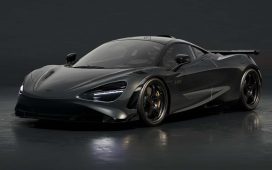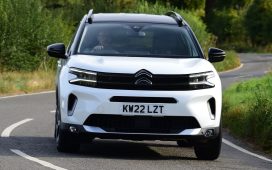There was a piece of good news about electric cars this week. Stellantis CEO Carlos Tavares said last year his company made a profit on electric cars. CNN reports that Tavares told the press after the company’s latest earnings call, “Stellatis’ strategy is very different… from the other competitors from Detroit. We’re keeping full speed on electrification.” The company reported its third straight year of record profits since the merger of Fiat Chrysler and PSA Group created the company in 2021.
Those profits from the sale of electric cars came exclusively from the European market. Stellantis will begin selling its next generation Fiat 500e in America in 2024. It also has some electric cars and trucks in the pipeline from its Jeeo, Dodge, and Ram divisions.
Taveras said it’s possible the company’s string of record profits will eventually end as it shifts more to EVs from traditional internal combustion engines, although he said that “I’m quite confident that 2024 will be better than 2023,” when the company had to contend with a six-week-long strike at its US operations. But he said that EVs, while profitable, are still not as profitable as traditional gas-powered vehicles. “We are working very, very hard to bring the profit margins of electrified vehicles to the same level as ICEs,” he said. “We are not there yet. But we are getting closer.”
Driving Down The Cost Of Electric Cars
Selling electric cars at a profit is a challenge, mainly because the cost of batteries is high. To compensate, manufacturers are searching for new ways to drive down manufacturing costs. Tesla is pursuing high pressure casting technology, which would substitute one or more cast parts for hundreds of stamped metal pieces that have to bonded, welded, glued, or bolted together. An additional benefit of castings is that the machinery to make them takes up less space in factories than traditional stamping equipment.
Tesla is said to be hard at work on a less expensive car that is expected to retail for around $25,000 but when — or if — it will go into production is anyone’s guess. The casting technology is supposed to make less expensive electric cars possible. CleanTechnica readers, who are all above average, know that what is promised is often not delivered. For instance, the new Chevy Equinox EV has a starting price $5000 higher than the company expected. The Ford F-150 Lightning is also $10,000 more expensive than anticipated.
GM is supposedly working on a new version of the Chevy Bolt, but what it will cost is far from clear. The original was the cheapest long range EV for sale in America, so of course Chevrolet stopped making it a few weeks ago, years before its replacement will be available.
Ford’s Skunk Works For Electric Cars
TechCrunch says Ford has created a high powered team of cost cutters who are working with Alan Clarke, a former Tesla and Ford Advanced EV development boss, in a so-called semi-secret “skunk works” in Irvine, California. Their goal is said to be figuring out how to build lower cost electric cars that Ford can still sell at a profit.
Ford CEO Jim Farley made a brief reference Tuesday during the company’s fourth quarter earnings call to a “skunk works” team is working on a “low cost” platform for electric cars. That team includes engineers from Auto Motive Power, the EV startup that Ford acquired in November, 2023. AMP founder Anil Paryani, who worked at Tesla along with Clarke for about five years, is also part of the skunk works project, which is working on a third generation platform for electric cars.
“We’re also adjusting our capital, switching and more focused onto smaller EV products,” Farley said during the company’s earnings call. “Now, this is important because we made a bet in silence two years ago and we developed a super talented skunk works team to create a low cost EV platform. It was a small group, a small team — some of the best EV engineers in the world — and it was separate from the Ford mothership. It was a startup and they’ve developed a flexible platform that will not only deploy to several types of vehicles, there will be a large install base for software and services that we’re now seeing at Pro” — the company’s commercial vehicles unit. Farley even went so far as to say Ford would consider working with another OEM — GM??? — to jointly produce cylindrical battery cells that cost less than those currently available.
The Chinese Invasion Of Electric Cars Is Imminent
US automakers had better hurry. It is generally believed that Chinese companies can manufacture electric cars for about a third less than legacy automakers. That means they could theoretically pay the 27.5% US import duty on Chinese made cars and still make a profit. The company that is causing the most concern is BYD, which sold more electric cars last year than Tesla — 1.6 million — and another 1.4 million plug-in hybrids.
The company is assembling its own fleet of cargo ships to deliver electric cars to Europe and other markets. This week, there are reports that BYD is actively seeking a suitable place to manufacture cars in Mexico. Citing various sources, Electrive says Zhou Zou, BYD’s manager in Mexico said recently a feasibility study for a Mexican plant is underway and plans are being discussed with local authorities.
And here’s the kicker. Electric cars built in Mexico would be eligible for the US tax credit/rebate, assuming their batteries comply with US sourcing rules for materials and components. Can you imagine a Chinese company sourcing its batteries from non-Chinese sources? That would set Joe Manchin’s head spinning, that’s for sure.
BYD is currently still concentrating production on its domestic market. However, more and more production facilities outside China are planned or under construction. In South America, for example, BYD is building a plant for electric cars and hybrids in Brazil. It is being constructed on a former Ford industrial site in the Brazilian state of Bahia.
BYD manager Stella Li announced in December, 2022 that the Chinese manufacturer was planning at least one car plant on the European continent, perhaps even two. Now it appears the company is moving ahead with construction of a factory in Hungary, where it already has an assembly plant for electric buses.
The Takeaway
There are cultural issues in play with BYD’s expansion plans. If China attacks Taiwan, the market for its cars outside of China will collapse. In addition, some Americans will refuse to consider a Chinese car for political reasons, just as after World War II, German and Japanese companies found selling cars in countries they had recently been at war with was a daunting proposition.
Despite those ancillary concerns, the allure of low prices is hard to resist. Many readers may remember when the Yugo — a recycled version of an obsolete Fiat model — took America by storm. It wasn’t a very good car, but it was cheap and that was enough for many people. If BYD can make inexpensive electric cars that are decent automobiles, they will find plenty of takers in America. The legacy automakers have every reason to be nervous as they stare down the prospect of their very own Nokia moment.
Have a tip for CleanTechnica? Want to advertise? Want to suggest a guest for our CleanTech Talk podcast? Contact us here.
Latest CleanTechnica TV Video
I don’t like paywalls. You don’t like paywalls. Who likes paywalls? Here at CleanTechnica, we implemented a limited paywall for a while, but it always felt wrong — and it was always tough to decide what we should put behind there. In theory, your most exclusive and best content goes behind a paywall. But then fewer people read it!! So, we’ve decided to completely nix paywalls here at CleanTechnica. But…
CleanTechnica uses affiliate links. See our policy here.










